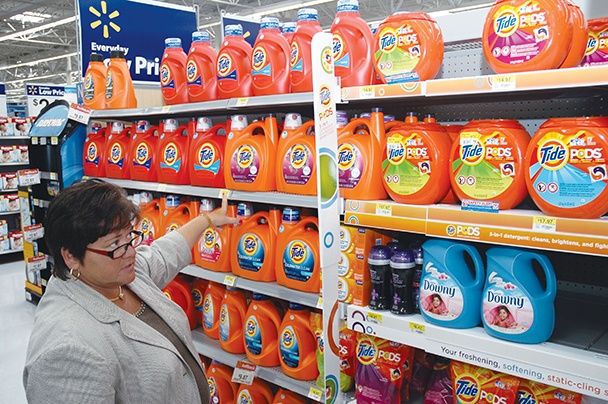Marketers Value Store Walks As Important Retail Ritual
by August 4, 2014 12:00 am 1,125 views

On a recent weekday morning in Fayetteville, Dina Howell and two colleagues strolled into a Walmart Supercenter with a plan.
Howell was looking for things, but not for things to buy. What she observes is quite different than what most shoppers see.
Where others shop, Howell goes to explore.
Howell is best known locally as the CEO of Saatchi & Saatchi X, an award-winning agency headquartered in Springdale, specializing in the industry niche of shopper marketing.
Her trips to the store are systematic. Her approach is to learn something by evaluating different parts of the store, identifying the way a product is presented and interpreting the behavior of shoppers who are there.
“For me, it’s just the shoes that I walk in; I can’t really look at it any other way,” Howell said. “I have trained myself to look at it that way.”
She inspects. She takes pictures. She asks questions — from up close and far away.
It’s the retail rite known in the industry as the store walk. Marketers make these information-gathering trips to develop insights about what they see, then use them to add value to marketing and sales strategies for their clients. In Saatchi’s case, those brands include Del Monte, Procter & Gamble and Wal-Mart Stores Inc.
Howell estimates she has been going on store walks for 25 years and said she visits four to five stores a week.
“Anywhere I travel, I will pop in a store,” she said. “The photos on my cellphone are either of my two kids or of stores.”
For retail geeks, which Howell would probably admit to being, the store walk is at the center of what built the concept of shopper marketing.
Essentially, the philosophy behind shopper marketing is that, by understanding the consumer’s behavior, the retail industry can better implement strategies such as display, coupons and placement to move the consumer to buy.
Janet Kirkbride, a retail consultant based in South Africa and a shopper marketing proponent, said the store is where everything happens.
“The idea is to bring traffic into the aisle and get traffic in front of your brand and your product,” she said. “Everything you are doing is for the purpose of getting attention, engaging shoppers and then converting them to a purchase.”
And what grabs attention can be subtle, Howell said, as long as it is disruptive. On this particular store walk in Walmart, when she was joined by her operations officer, Brittney Duke, and Betsy Reithemeyer, vice president of communications, Howell pointed out the packaging of GoGo squeeZ, a squeezable apple sauce.
“Look at their packaging,” Howell said. “They came out with a lime green package. There is nothing in the category like that. Everything else in the category — Mott’s, Musselman’s — their packaging is all kind of that apple sauce-y color. [GoGo squeeZ] came out with lime green. Very disruptive.”
Howell said she often visits with shoppers in a store, who are generally very welcoming, considering they are being asked random questions from a stranger.
“In fact, if we are in a store walk and don’t have a cart, people think we work there and will ask for information or directions,” Howell explained. “And I always take that opportunity to talk.”
Al Wittemen takes his store walks even further. Considered a pioneer in shopper marketing, Wittemen is passionate about the practice, and has even written about it in a book called “Walk Like a Shopper: A Practical Guide to Understanding the Retail Ritual.”
Wittemen, an executive at St. John & Partners in Jacksonville, Florida, said he doesn’t believe enough time is spent getting inside the skin of a shopper.
To that end, he suggests store walks can be conducted while placing fennel seeds in shoes to simulate sore feet, wearing a weight belt to simulate obesity, taking along small children to find out how distracting they can be for a parent, or using a store’s motorized shopping cart to better understand the challenge.
He has done all of those things. Why does he go to such great lengths and spend most of his time in stores?
“It’s simply the best way I know to gather shopper insights, understand shopper behavior and learn about a customer,” he said. “There’s just no substitute for being there, and if you don’t understand your consumer as a shopper, you don’t understand your consumer.”
